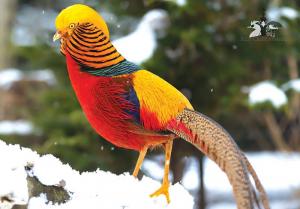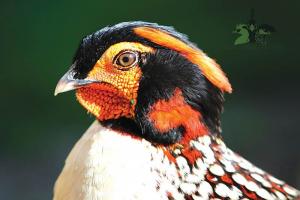He Raises Rare, Exotic Pheasants
If you think ring-necked pheasants are pretty, wait until you see the pheasants that breeders like Alex Levitskiy raise. Like the ring-necked, they originate in Asia, some so rare that they were thought to be extinct. Levitskiy turned his passion for the beautiful birds into a business.
Breeding wild bird species is full of ups and downs, says Levitskiy. He notes that you can address all the husbandry needs of a species as best you can and find the birds still don’t display any breeding activity. Breeding wild birds is a learning experience, he adds.
Levitskiy advises starting with common species, such as ring-necked or domesticated poultry. He grew up around domestic pigeons and chickens, which provided him with basic husbandry skills. His parents gave him an Indian peafowl around fifth grade. From there he progressed to a variety of exotic species.
“Join bird organizations like American Pheasant and the Waterfowl Society and reach out to people. Creating a network of mentors allows one to compare different husbandry strategies and apply that knowledge to your own specific situation.”
Being able to supply a natural habitat is important for exotic species, adds Levitskiy. “Understanding the bird’s natural history is crucial, even if you can’t replicate a mountain or rainforest,” he says. “This is where improvisation comes into play. For pheasants it is ideal to have a well-planted aviary with sufficient cover to behave normally. Just because you can breed a bird in a small, muddy pen with no greenery doesn’t mean it is best for the bird.”
Levitskiy’s website reflects his current 7 breeds of pheasant and 8 breeds of duck. He also keeps a rare breed of goose and one of peafowl.
He enjoys the challenge of breeding a new species, especially ones not well represented in the U.S. If no one focuses on them, they will be lost to breeders here, he notes. The species in his collection range from the ‘least concern’ golden pheasant to the ‘vulnerable’ Cabot’s tragopan, the ‘near threatened’ satyr tragopan and the ‘critically endangered’ Edward’s pheasant. Rediscovered in Vietnam in 1966, Edward’s pheasant had been thought to be extinct in the wild.
Levitskiy operates Blue Creek Aviaries as a business. However, the prices of his birds are not disclosed until buyers have been educated and informed about exotic bird care and breeding.
“I want people to take time to research a species, ask questions and determine if it is suitable for their setup,” says Levitskiy. “Then we discuss cost. Most reputable breeders are not in aviculture for the profits. It is a labor of love, and the prices for the birds go to recouping the expense of raising them.”
Levitskiy sells surplus breeding stock as full-grown birds, not as fertile eggs or chicks. He explains that shipping is harsh on eggs and on chicks. Chicks can be hard to raise, so he prefers to do that and sell the easier to care for (and sexed) adult.
Due to his academic schedule, Levitskiy asks readers contact him via his email and expect a likely delayed response.
Contact: FARM SHOW Followup, Blue Creek Aviaries (alevitskiy98@gmail.com; www.bluecreekaviaries.com).

Click here to download page story appeared in.
Click here to read entire issue
He Raises Rare Exotic Pheasants LIVESTOCK Poultry If you think ring-necked pheasants are pretty wait until you see the pheasants that breeders like Alex Levitskiy raise Like the ring-necked they originate in Asia some so rare that they were thought to be extinct Levitskiy turned his passion for the beautiful birds into a business Breeding wild bird species is full of ups and downs says Levitskiy He notes that you can address all the husbandry needs of a species as best you can and find the birds still don’t display any breeding activity Breeding wild birds is a learning experience he adds Levitskiy advises starting with common species such as ring-necked or domesticated poultry He grew up around domestic pigeons and chickens which provided him with basic husbandry skills His parents gave him an Indian peafowl around fifth grade From there he progressed to a variety of exotic species “Join bird organizations like American Pheasant and the Waterfowl Society and reach out to people Creating a network of mentors allows one to compare different husbandry strategies and apply that knowledge to your own specific situation ” Being able to supply a natural habitat is important for exotic species adds Levitskiy “Understanding the bird’s natural history is crucial even if you can’t replicate a mountain or rainforest ” he says “This is where improvisation comes into play For pheasants it is ideal to have a well-planted aviary with sufficient cover to behave normally Just because you can breed a bird in a small muddy pen with no greenery doesn’t mean it is best for the bird ” Levitskiy’s website reflects his current 7 breeds of pheasant and 8 breeds of duck He also keeps a rare breed of goose and one of peafowl He enjoys the challenge of breeding a new species especially ones not well represented in the U S If no one focuses on them they will be lost to breeders here he notes The species in his collection range from the ‘least concern’ golden pheasant to the ‘vulnerable’ Cabot’s tragopan the ‘near threatened’ satyr tragopan and the ‘critically endangered’ Edward’s pheasant Rediscovered in Vietnam in 1966 Edward’s pheasant had been thought to be extinct in the wild Levitskiy operates Blue Creek Aviaries as a business However the prices of his birds are not disclosed until buyers have been educated and informed about exotic bird care and breeding “I want people to take time to research a species ask questions and determine if it is suitable for their setup ” says Levitskiy “Then we discuss cost Most reputable breeders are not in aviculture for the profits It is a labor of love and the prices for the birds go to recouping the expense of raising them ” Levitskiy sells surplus breeding stock as full-grown birds not as fertile eggs or chicks He explains that shipping is harsh on eggs and on chicks Chicks can be hard to raise so he prefers to do that and sell the easier to care for and sexed adult Due to his academic schedule Levitskiy asks readers contact him via his email and expect a likely delayed response Contact: FARM SHOW Followup Blue Creek Aviaries alevitskiy98@gmail com; www bluecreekaviaries com
To read the rest of this story, download this issue below or click
here to register with your account number.








